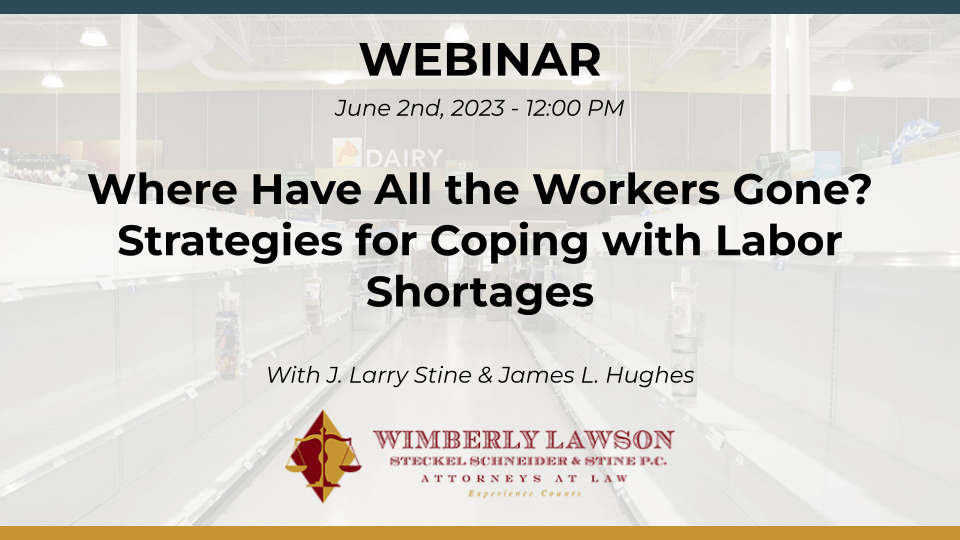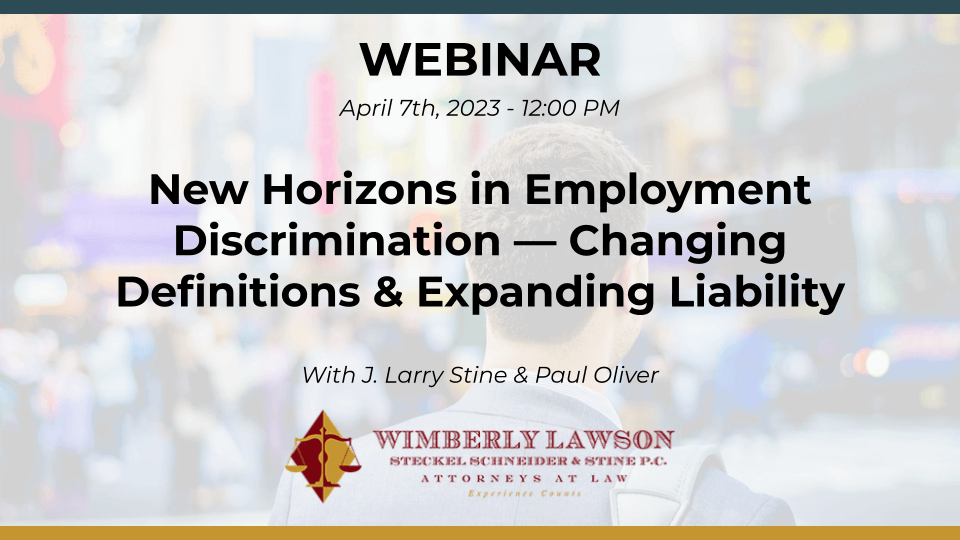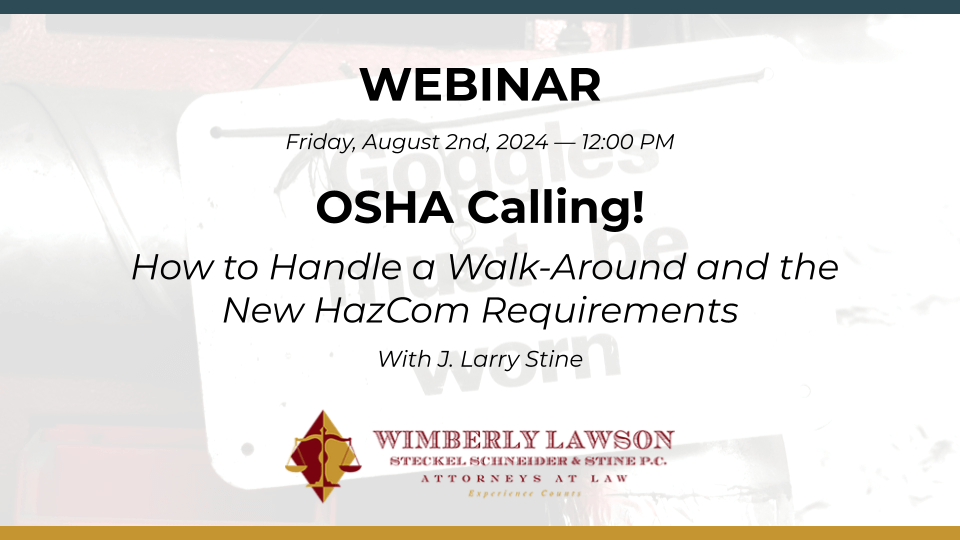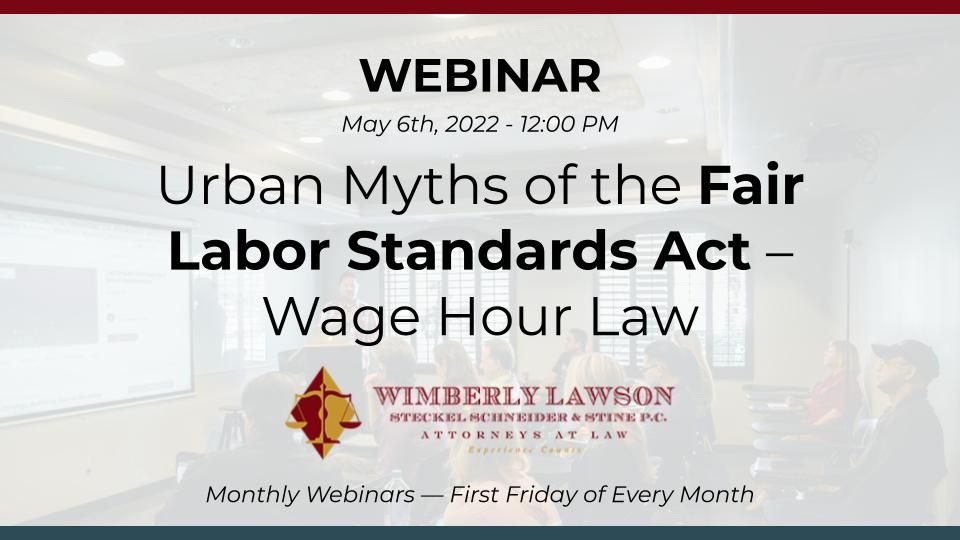
Where Have All the Workers Gone? Strategies for Coping with Labor Shortages
The declining workforce participation is resulting in job vacancies almost double the number of available employees. This webinar explores alternatives such as Immigrant and nonimmigrant visa programs, temp and staffing agencies, prison labor, and part-time and remote options for employers struggling to fill vacancies.
Presented by J. Larry Stine & James L. Hughes.
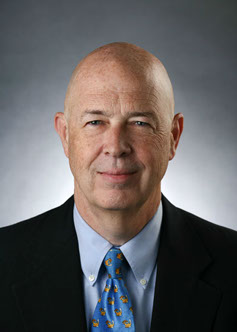

Watch This Webinar
Webinar Transcript
J. Larry Stine (00:00):
Welcome to the session where all the workers have gone, and Jim Hughes and I will be trying to talk about this particular issue. Where's, what's some suggestions? We have reasons why we see the problem and possible solutions. I don't know if we have all the solutions and matter of fact, I know we have all the solutions. The, the interesting thing is when we look at it, we look at the statistics for the labor force participation and in February of 20, the labor participation was 63.4% is now down to 62.6%, which means even though the pandemic was officially over on May 11th, the workforce labor participation is still down. And so one of the things we're gonna look at is one where they all gone. And then we're gonna try to see what we can suggest for coping with some of these strategies. So, Jim, we got the PowerPoint, put that up.
James L. Hughes (01:08):
I think it's worth noting that while percentages are one way of looking at it the real numbers are that we're about 4 million workers short in the labor force. Let's talk about what happened to all the workers. You can certainly recognize that Covid 19 had an impact on the workforce during the time that Covid 19 was such a problem for many people,
J. Larry Stine (01:50):
That it was
James L. Hughes (01:52):
In addition to covid 19, you've got a shrinking workforce. The demographics show that a lot of people are getting older and you have a, a younger workforce that's much smaller than what it was when the baby boomers were in their full employment mode. So you've gotta recognize that there will not be as many workers in the workforce for the next several years unless immigration or birth rates change <laugh>.
J. Larry Stine (02:30):
Right.
James L. Hughes (02:32):
Do you have any,
J. Larry Stine (02:33):
The interesting thing though is the retirement cause of the covid
James L. Hughes (02:36):
Yeah.
J. Larry Stine (02:38):
Increased also. So more people retired than would've normally retired because Covid was such a difficult time.
James L. Hughes (02:44):
Right. And now there are 3 million fewer workers in the workforce than in February of 2020.
J. Larry Stine (02:55):
Right. And yet there's a whole lot more
James L. Hughes (02:57):
Jobs. There are a whole lot more jobs and not enough unemployed people to fill all of those jobs. There are some other reasons for that. Certainly government benefits have been a problem for retaining workers or, and attracting workers. And some of the benefits depend on what state you reside in. You see the comment about benefit cliffs and that relates to whether a state has expanded Medicaid coverage or, or not. Right. And in those states where Medicaid coverage has not been expanded people who might otherwise be inclined to work will are not going to work because that affects their healthcare benefits and, and that sort of thing. Also, you've got low pay for some jobs that discourages workers from seeking employment during Covid. There was an unusual circumstance where household savings increased because people were not going out and spending money. Well,
J. Larry Stine (04:13):
Not only that, but the unemployment benefits that were being paid Right. Were, were greater than what they were earning. One of my daughters in fact got when Covid hit, got laid off in the first week of the shutdown and proceeded to make more money because the way the benefits were set. So she actually made more money on unemployment. Mm-Hmm. <Affirmative>. And that lasted quite a long
James L. Hughes (04:39):
Time. Yeah. the covid supplements of course, have gone away, but there are still some situations where total household income has increased to the point that a lot of women are not returning to the workforce cause they're staying home with their children and the husband is providing enough income for them to live. Another significant problem that keeps women from being in the workforce is the lack of access to childcare.
J. Larry Stine (05:14):
Right.
James L. Hughes (05:15):
And we'll be talking more about that later. Some people still have health issues from Covid and for other reasons and have not returned to the workforce for that reason. Then you have a lot of people who are seeking more education and training so that they can go into the workforce and acquire a better job.
J. Larry Stine (05:38):
Right. Well, you can't blame them <laugh>, really, but, but that's, but there are shortages and they're more educated decisions also. So
James L. Hughes (05:46):
That's right. Give
J. Larry Stine (05:47):
A little time. Those people will be coming back into the, the workforce, but at a higher level of employment. So there is that particular aspect of where all the workers have gone and, and some of 'em just still are, haven't made that transition to where they need the money despite the the current situation where the interest rates are, are going up. And so it's sometimes it's a combination of low pay and they still have the benefits and they're still hanging out and waiting for things.
James L. Hughes (06:22):
So how do we deal with these labor shortages, Larry?
J. Larry Stine (06:27):
Well, there is more than a few ways to do it. I'll start with automation. So basically I'll, I'll use an example. I was, it was in a poultry plant recently that had not been using automatic de-boning. And the reason they hadn't been using automatic de-boning is that skilled human beings are better than robots. However, unskilled or poorly trained or lightly trained employees aren't as good as the robots. So what they had to do, eventually, they just couldn't get enough people to work on the deone systems. And so they've automated some of those lines to take an account for that. Now, one of the transitions, they're go in from lower skilled workers to a higher skilled worker, cuz now the workers are not de-boning their operators who are responsible for the the equipment. So there is automation and you know, we go to restaurants now where I, I went to a restaurant recently and there was like two servers, but I had a little computer where I could do everything. And basically the servers were just delivering the food and not doing much of anything else. So automation helps to some, but it's not a complete solution. Not everybody can automate.
James L. Hughes (07:50):
Yeah. And certainly the there are staffing companies out there who are willing to provide workers to the extent they can. Another approach is to think about flexible scheduling and using part-time workers. There are people in the economy who are willing to work part-time in a way that does not necessarily affect their other benefits, right. That they receive. So if an employer is willing to use part-time labor in a way that still helps the employer and is attractive to the potential worker, that's an option.
J. Larry Stine (08:37):
I'm, I'm aware of one employer who actually has a scheduled four hour shift and they, they run shifts so that they're going 10, 10 and four. So they have 10 hour shift, 10 hour shifts, and they have a four hour shift. And that's part of what they're doing for that four hour shift is trying to appeal to people who can do the part-time schedule. And that seems to have some level of work with the, the staffing companies. We've been dealing with a lot of staffing companies and some of our problems though tend to be that some of them are not following the I nine and he verified very closely. And so we're ended up with some staffing companies that run into some issues with immigration justice. For example, we had a case where, and one of our clients was using a staffing company and they got prosecuted because none of their employees were legal.
James L. Hughes (09:37):
The staffing company employed
J. Larry Stine (09:39):
The staffing company employees, not the, not our clients <laugh> employees. They were following the ions and they verified properly, but the staffing company wasn't, they were, frankly, the owners of the company were criminally prosecuted and convicted. So you have to watch your staffing companies and so you have to be careful of that particular issue. But it is an opportunity. And I have dealt with other staffing companies that know how to do the I and legit workers. So you gotta, you gotta pay a little attention to who, who your staffing company is and what they're doing. But it is an opportunity, but it does come with a cost. Typically the costs for your workers from staffing company are higher than the ones that you can hire correctly.
James L. Hughes (10:22):
Yeah. You're usually paying about 30 to 40% more just to have that worker in your facility.
J. Larry Stine (10:29):
Right. So it it, it is a solution, but it's an expensive
James L. Hughes (10:34):
Yeah. Remote workers is an option for those in an office environment. It doesn't really work in a plant environment so much. Yeah. But allowing people to work remotely has become very attractive cause of covid and the remote work that was allowed during the Covid pandemic. So that is something that employers still need to consider. Yeah.
J. Larry Stine (11:01):
But you can see when you look at some of these companies that have been almost all remote are now trying to bring them back in and they're running into some severe resistance cuz some of 'em become so enamored with remote work that they're having trouble bringing them back into the
James L. Hughes (11:17):
Well, Elon Musk knows how to deal with that
J. Larry Stine (11:20):
<Laugh>. Okay. He does know how to deal with it. That is a possibility. There's always termination is, is a possibility if you are trying to transition back from remote workers to Yeah. To local workers.
James L. Hughes (11:35):
And certainly some employers have the opportunity to use prison or transitional center or work release labor. And, and that usually works pretty well in a manufacturing or processing environment. You got any thoughts on that, Larry?
J. Larry Stine (11:56):
Well no, I've, I've watched them do it and, and the interesting thing about it is, you know, you get a high turnover that, but what I have noticed is that there is a percentage that comes from these prison transitional work release that become very solid employees and, you know, they've got their life straightened out. And so even though it's not a high percentage you're retaining after they release, there is some, and it's, it is an opportunity. You have to be cognizant of what they're doing. And the other problem is that the prisons, transitional centers, cause that has happened of have an event and all of a sudden they withhold all the workers. And that can be a problem for the employer, whether you got a large percentage of prison or transitional work, work release programs. But it is an opportunity in, in some places it's better and it is a manufacturing type job that seems to be best suited for that type of program.
James L. Hughes (12:59):
And certainly higher pay can attract workers. I was talking with a client a few days ago and they have adopted an attendance bonus program where they will pay a worker who satisfies the attendance requirements for the week ans for $3 an hour in their regular pay if they show up for work.
J. Larry Stine (13:24):
I just caution attendance bonuses are a part of the regular rate for overtime purposes. So if you give an attendance bonus, you gotta remember put it into the calculation of the regular rate if you give them to, because they're considered non-discretionary bonuses. Right. But, but they do, they do work, they work quite well. And you can see when you look at companies that use them, their attendances tend to be much higher because that bonus can be very significant. Three
James L. Hughes (13:54):
A lot. And just to give you an example, let's say the normal rate would be $12 an hour, but the bonus of $3 an hour would bump it up to $15 an hour. So if you have overtime, you're paying overtime on a $15 an hour rate.
J. Larry Stine (14:14):
Right. You're in that circumstance, right. An extra dollar 15 for overtime an hour. You, but frankly with the labor shortage, I think most people are, we're kind of glad to be able just bit of
James L. Hughes (14:28):
Work. Yeah.
J. Larry Stine (14:29):
We, we see signs that we still are, when we drive about and see some of our clients, we see signs that I've talked to clients and, and the bigger facilities and they're telling me they, well I'm 50 short. I'm a hundred short. So at that point they're willing to do something because they're, that's really impacting their production capabilities.
James L. Hughes (14:51):
Yeah. The next thing is childcare assistance. Larry and I have had extensive discussions about this. Cause we are both aware of the importance of childcare assistance in attracting workers. In fact, my daughters attended a school where the teachers and staff were allowed to bring their children to the childcare program. And Larry has a similar experience. I
J. Larry Stine (15:20):
Do and I have a personal experience. Back when I was first starting working for the government, my wife and I were looking to see where she could work. And I had three young children at the time. And when I started doing the calculations of how much money the childcare came and expenses and how much my wife could earn to start off, I came to the conclusion we'd be losing about $4,000 a year. Cuz she went out into the general workforce. Now we, we did solve the problem because she became a childcare employee and they gave her childcare as part of the the deal. And so even though she made a much lower hourly rate she was able to work. So one of the things that we, we, we think you can suggest because the statistics are really quite large, is that something like 25% working force is probably not coming back because of childcare assistance.
J. Larry Stine (16:13):
And as Jim says, we are aware of someplace like the stool his wife worked at that actually provide daycare services for the employees as part of the program. And that problem is particularly onerous when you get out into the rural communities because the childcare in the rural community is much harder to, to find. So those people who have a much larger problem and need a lot more people might consider trying to get childcare services at their facility where they can bring the children in and they can work it, it is probably no more expensive than what they're trying to do with some of these that pay that they have to pay the staffing companies for the premiums. They're getting to the same people. So it is a possibility. And any, there is a large pool of people part that we looked at said something like 24% and that's, that's a big chunk of people that can't come in the workforce because the childcare systems and all the expenses exceed what they're earning.
James L. Hughes (17:19):
Yeah. And certainly skills training is something that is attractive to potential workers. If you have a relationship with a, a tech school or a tech college you may be able to find workers in that environment. And it's certainly worth the effort. Some workers are also still fearful <laugh> of covid 19. So you, you should consider what your covid 19 protocols will be now that the pandemic is over. And is there a way that you can give people comfort who are steer still fearful about contracting covid 19?
J. Larry Stine (18:10):
Yeah, one of the ways I've seen it is they let them continue to wear their, their mask when they go into the facility and make some of them feel more, more comfortable. Other than that, the, the, the problem is I think mostly Americans tired of the protocols that came to date. I, I mean, not recently. I went to the Emory University doctor's office and they had dropped the mandatory mask into the facilities. And that basically occurred on May 11th when the emerge when the pandemic emergency was declared over.
James L. Hughes (18:51):
So yeah, I'm still going to a doctor's office that requires wearing mask for staff and patients. So, yeah.
J. Larry Stine (18:58):
Interesting. Okay.
James L. Hughes (19:01):
The last thing that, or the last area that you can look at is the immigration laws. And we'll talk a little bit about that. There are various kinds of temporary workers that you can seek <laugh> through the use of the EM immigration laws. One type are H1B workers or professionals. The typical requirement for a professional worker is that they have completed a course of college education, for example, in marketing or accounting or any of the other professions. The problem with attracting professional workers is there's a pretty significant cap. And presently there is a lottery held each year to determine which of the H H1B applicants will be allowed to enter the United States. So you have a lot, you might have a quarter of a million applications for H one B workers and they will only allow 66,000 to come into the country. You also have H two a classification for seasonal agricultural workers. And Larry, you've done a lot of work with H two A
J. Larry Stine (20:30):
I I have. And it is one of the few programs that does not have a cap to it. It is basically if you can qualify for the H two A program and you can bring the people in, yes. It, the process is absurdly complex. Whoever did it must have been, you know, somebody to design root cope or machinery because it involves so many different agencies in the processes. Quite complicated. And honestly for H two A you pretty much need to have somebody who is a processor for H two A to get them through. But if you can get them characterized as a seasonal agricultural worker under H two A and they, the number is not capped and therefore we get a very significant large number of seasonal agricultural workers
J. Larry Stine (21:24):
Coming in. But one of the interesting things that we're finding oddly enough recently is that while the government is allowing, you know, the board be just overwhelmed by illegal immigrants or undocumented workers, take your choice. They are being harder and harder on the employers coming in onto the H two A program. You know, recently I've had two cases in which they're proposing to barment in their first investigation, which I haven't seen before. So, but it is an opportunity and the season agriculture worker, it has certain requirements, but you can be creative with agriculture workers to some degree. But it's, but it is primarily for agriculture workers. And the problem is it's supposed to be seasonal except for a few people. And, and they make exceptions for like goats and cheap race. They give them more, they can be in the country longer than just a year, but the rest of 'em were, they're pushing back. When you get beyond 10 months, they, if they said more than 10 months, they're denying the H two A applications.
James L. Hughes (22:36):
Yeah. And just to be clear through processing operations are not agricultural operations.
J. Larry Stine (22:43):
No, they're not at all. No, no. Boat, tree and cattle processing
James L. Hughes (22:48):
Construction is not agricultural.
J. Larry Stine (22:51):
No, no, it's not, it's not agricultural. Theoretically it can cut all under the H two B standard, but the problem in the htb, like the H one B is it's got a cap.
James L. Hughes (23:02):
It's got a cap. That's right.
J. Larry Stine (23:04):
And it, and they do it twice a year and they now have to do basically, you know, the lottery on who gets your H T V workers and the cap is ridiculously Yeah. The reality is the need as far as exceeds it.
James L. Hughes (23:24):
Yeah. And it's important to recognize that for H two B there is some flexibility for an immediate need that can last longer than 10 months. We've had one client who was able to keep workers for a couple of years because of the shortage of labor in their vicinity. But there are some hoops to jump through.
J. Larry Stine (23:54):
There you go. There are, there are quite a few hoops to <laugh> to jump through for either for all of them. And the funny thing though, Jim, is that process isn't different for them. Like the H1B process is not the same as the H two A process. Right. Matter of fact, they're very, very
James L. Hughes (24:11):
Different. They are different
J. Larry Stine (24:12):
Processes. So <laugh>, depending on which one you're gonna pick, you better know what the process is or get somebody that knows what the process is. You get these workers from the, these particular programs
James L. Hughes (24:25):
Now moving from just the basic labor to managers and executives, you can bring in, if you have international operations, you can bring in managers and executives from your other international operations to the us. In addition, if you have workers in your international operations who have specialized knowledge, those workers can be brought to the United States through the L one B program. And there are no caps on L one A and L one B. For some strange reason, <LAUGH> or government has given parole status to Cubans, Haitians, Nicaraguas, and Venezuelas. And they're allowing 30,000 per month to come into the country and receive work authorization. These people need US sponsors though. And it's not an employment sponsor. It is a financial support sponsor. And I would be uncomfortable <laugh> placing my net worth <laugh> Right. As supporting one or more of the people coming in from these countries.
J. Larry Stine (25:40):
Well, you know, we've, we've looked in, and it's not on the slide, but we've done this for, looked at it from Puerto Rican workers and working with the Puerto Rican Secretary of Labor and they have some very substantial financial issues. But we have had some clients that have been so desperate for workers that we have gone to Puerto Rico and worked with the Secretary of Labor and actually gotten them up despite the fact that you gotta have a lot of requirements to maintain, basically to provide them financial support and support and room board. You know,
James L. Hughes (26:14):
And I have heard that some employers are not pleased with the workers they get from Puerto Rico.
J. Larry Stine (26:20):
That's true too. <Laugh> Well, that, you know, that, that, you know, the other problem sometimes would be some of these H two and HBS is we do, they actually employees do a pretty good job, but there's always seems to be a few that kind of show up for work under the H two A visa and then they leave immediately. In other words, it's a legal way to get, get across the country and then they just go into the economy because the H two, H two B are employer specific, they're only authorized to work for a particular employer.
James L. Hughes (26:54):
Right.
J. Larry Stine (26:55):
And they don't work for those employers. They just disappear. Government requires you to file a report of abandonment, or if you don't follow the report for abandonment, they want you to pay them. Although I haven't quite figured this one out, that they on a three quarter guarantee for people who abandoned in your report. But you can report it, but you can't find them anywhere.
James L. Hughes (27:15):
That's government for you. That
J. Larry Stine (27:16):
Is the government. It is true.
James L. Hughes (27:18):
And then you have probably heard about how the Biden administration is allowing people to enter the country through parole. And those people who enter through parole are given the opportunity to apply for work authorization unless they receive that work authorization. They can seek employment. Then there are people who have been in the country for many years from various countries who have temporary protected status. At some point that temporary protected status will end. But as you know a lot of people have been here for 10 or more years of temporary protected status.
J. Larry Stine (28:01):
But it, it's interesting, Jim, I went to a a detention, an immigration detention center to free one of the H two A workers who had been improperly retained. And I went to a hearing, and when I went to the hearing, one of the interesting thing was this, these people who were undocumented workers and the immigration judges were given the authority if they were married or had a child and hadn't gone back to the country, they could actually apply to stay in the country. It was given to the the lj but it looked like they were, if they met those criteria, they were immediately offered that opportunity to stay into the country because they had an American spouse for American children. And I saw during the hearing, there was like 20 of them, four of them were offered, two of 'em were divorced and both of them declined to stay in the country.
James L. Hughes (28:53):
But
J. Larry Stine (28:53):
It is an opportunity, we don't know about it. For people who are undocumented, have been in the country a long time, when they go to the, the court the hearing before the immigration ALJs, they're given an opportunity to stay in the country legally.
James L. Hughes (29:05):
Yeah. Then there are immigration laws that deal with permanent workers. Certainly executives and managers who you have brought in from international operations are pretty much guaranteed a permanent resident card. Once they complete all the requirements, then you have to go through a labor certification process for skilled and unskilled workers that can take some time. There are companies who are specializing in bringing in workers from certain countries like Korea Mexico, other places as skilled and unskilled workers. And there are several companies out there doing that, that will assist employers in bringing in skilled and unskilled workers. But it does take time and it's an expensive process.
J. Larry Stine (30:09):
Yeah. The problem is the numbers that you can process at one time, right?
James L. Hughes (30:13):
Yeah. Yeah. You, you can only bring in just a handful each time. But it is a way to bring in workers and typically those workers have to make a commitment to work for you for at least one year. Then there are certainly a, a flood of refugees and asylums. You have the people who are coming in from Afghanistan and then some people who are making refugee and the asylum claims at the border. There is an organization called Tent Partnership for refugees@tent.org that has attracted a lot of interest from many employers. And it's easy for an employer to become a member because membership is free. Let's free the price <laugh>, but you can work with 10th partnership to see if there are ways to attract refugee labor to your place of employment. I've also included on this slide a list of contact information for people in Georgia. If, if you are a Georgia employer who has labor needs, you can try and work with these different organizations you know, cap Catholic Church Lutheran Services and those sorts of things are available in many states. So that is a source. Sometimes they're very hard to get in touch with. Right. <laugh>,
J. Larry Stine (31:50):
I, I, I do know that Clarks in Georgia has a very large refugee group of folks, and I know, I've been aware that they've been very successful in getting employed out of Clarkston because it's easy to get to. I was at a Oakley plant north of Gainesville one day. Mm-Hmm. <affirmative> and I sat there and watched about five 15 passenger vans come in and the ship change and they were all coming from Okay. The refugee area. And
James L. Hughes (32:19):
Clarkston, Clarkston
J. Larry Stine (32:21):
And I talked to em about it and they have a, they're, they're pretty happy with that type cause these people have a high level of success and, and a great incentive. Like they have to be employed to stay in the country, so they wanna stay employed and so they tend to be pretty good in 12 weeks.
James L. Hughes (32:37):
Yeah. these are some other resources that you can read that discuss the labor shortage in the country and gives you some ideas about what you can do. And we can make this whole PowerPoint presentation available if you want to send us an email and ask for it. I guess at this time we'll open the floor for questions if anyone wants to ask questions. Well, if you have something good for the benefit of the group, I'll ask you to unmute and say what you think about how to attract workers.
J. Larry Stine (33:30):
Yeah. We have two fundamental issues, Jim, that is getting the American workers to come back to the workforce and an immigration programs. We have that seems to be two fundamental ways we can do it right now. That seems to be the limitations we have.
James L. Hughes (33:45):
Yeah, certainly the immigration laws do not allow for enough workers to enter the country to provide the type of labor that a lot of the people in this webinar need. Yeah.
J. Larry Stine (33:59):
I, I was looking at the size of the workforce. When they sit in many of these requirements and limitations and the workforce, the, the economy has tripled in size from basically about 9 trillion to 21 trillion. And they haven't changed any of these programs. Part of the problem is the immigration Reform Control Act 87 set up an un unworkable compromise. It, it was a political compromise, but it is unworkable as a statutory purpose. So it really kind of causes some problems that congress still hasn't seemed to exercise the political will to fix or increase the size of the programs. These programs need to be increased substantially. I suspect we could easily bring in 2 million people. One of the things else I've noticed when I, and I've talked to other people about it, is one of the things about the, the people coming into the country is they want jobs.
J. Larry Stine (34:56):
They don't necessarily want to leave their homes where they, they live and where their brothers and their sisters and their parents and all live and where their home is. They just wanna come to the United States and work. So some of these H two aqb, these other programs where they're coming in and going out they cap is part of the problem for a lot of them because there's a lot of people who would rather come in work, make them make the earnings and go back. And yet we're putting barriers in front of these folks to keep them from coming into the, the United States factoring these camps on. And one of the myths that seems to be argued in Congress is that they're taking jobs away from Americans. I can give you an example. We had a case where in the Georgia Lit Group, rural legal services decided to really get a whole bunch of people to come in from a domestic city and Georgia to a farmer to take these jobs.
J. Larry Stine (35:58):
And they brought in well over a hundred American citizens and the farmer took them over within two weeks, the number of domestic workers still working at the farm after two weeks from that, over a hundred employees was one that particular person, by the way, completed seasoned. And so there's kind of a myth that we're taking jobs away from Americans for a lot of these jobs that they're just not, not applying for. And that seems to be part of the political resistance to increasing the number of workers that we could bring in. And a in a, in a program like that where they still get to live at home coming the United States and earn more money, they make significantly more than the United States than it goes a lot further if they go back to their homes. So it's one of the things that we don't have the seem to have the political will to increase it. And so perhaps one of the things that we need to do is talk to our congressman and senators about, about this. Maybe one day they'll finally come together for resolution of the, of this issue. And it's extraordinarily difficult problem that have so many of the people, there's so many jobs open and we can't get the people into the pro, into the into the jobs.
James L. Hughes (37:16):
Yes.
J. Larry Stine (37:17):
And it's not simply a matter of which race rates seem, which seems to be the solution that one group seems to always raise, pay more money and you'll get more Americans to come in and that's not necessarily true.
James L. Hughes (37:28):
Yeah. And the labor statistics indicate that there are still 4 million job vacancies if everyone was fully employed. So we're going to need more labor.
J. Larry Stine (37:40):
So think about that. I mean, if, if we everybody came in the United States went and got a job, we we're still short 4.4 million jobs. Where the heck are we going get 'em from? That's right. I mean, and basically there's really immigrants or people who have let them come into the country work for a while and go back home and take our money can go a long way back where they are. And it's a win-win I think for both the American employer and the the migrants. However, I will tell you, there's a recent article by one of the <inaudible> agricultural enforcement where he went in and he basically called the the programs close to slavery and accused the housing of being subhuman. I've been to those housing they're dormant towards, they're not subhuman, they're dormital, you know, bunk beds, a bar. They're these temporary staying, they're not staying, they're just staying there and going back. So we do have some real resistance inside the government to some of these programs because of the way they view the employers in the United States. They really do at times kind of characterize 'em as oppressor versus oppressed and there's a political issue of that particular concern. Yeah.
James L. Hughes (38:56):
Well anything else to add Larry?
J. Larry Stine (38:59):
No, I think we were about finished it off. He said we would go about 45 minutes with this one. Cause we'd like to tell you we got all the solutions, but we got suggestions. <Laugh> is what we have and some of them that we think will work. And you know, think about some of them. If you're large enough and you can run a get childcare, you know, you might be able to really attract some people that you otherwise, there's certainly a large group of folks that can't come out because of the childcare issue.
James L. Hughes (39:30):
That's true. Well, thank you for joining us today and we wish you a good, happy weekend.
J. Larry Stine (39:37):
Yeah, thanks a lot. Bye y'all.
